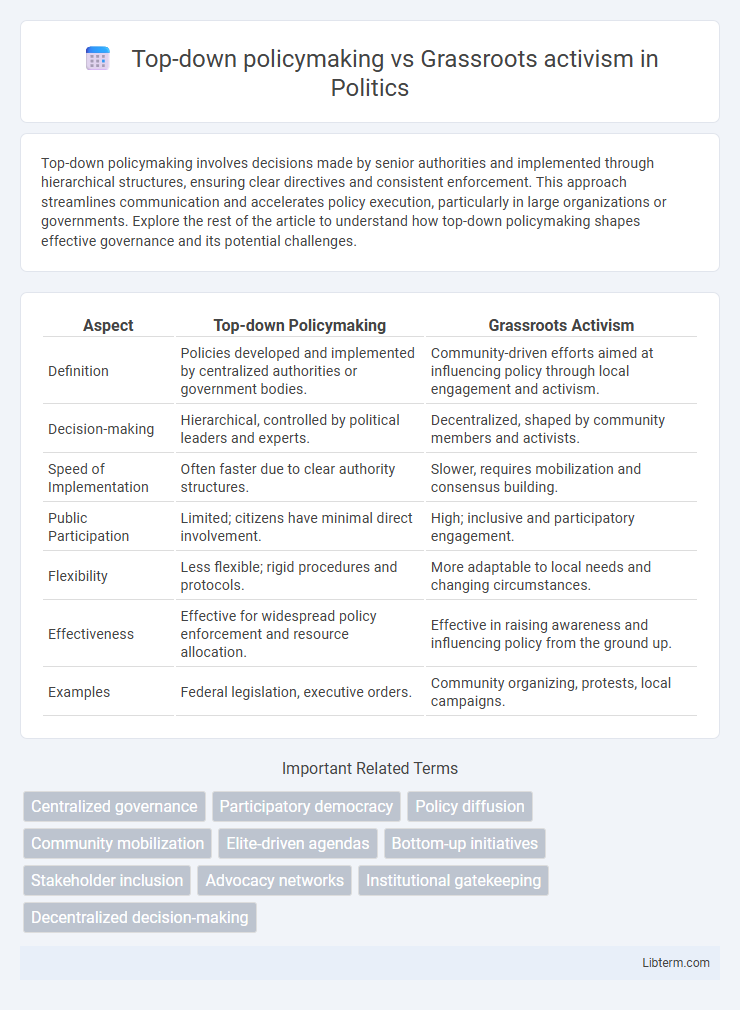Top-down policymaking involves decisions made by senior authorities and implemented through hierarchical structures, ensuring clear directives and consistent enforcement. This approach streamlines communication and accelerates policy execution, particularly in large organizations or governments. Explore the rest of the article to understand how top-down policymaking shapes effective governance and its potential challenges.
Table of Comparison
| Aspect | Top-down Policymaking | Grassroots Activism |
|---|---|---|
| Definition | Policies developed and implemented by centralized authorities or government bodies. | Community-driven efforts aimed at influencing policy through local engagement and activism. |
| Decision-making | Hierarchical, controlled by political leaders and experts. | Decentralized, shaped by community members and activists. |
| Speed of Implementation | Often faster due to clear authority structures. | Slower, requires mobilization and consensus building. |
| Public Participation | Limited; citizens have minimal direct involvement. | High; inclusive and participatory engagement. |
| Flexibility | Less flexible; rigid procedures and protocols. | More adaptable to local needs and changing circumstances. |
| Effectiveness | Effective for widespread policy enforcement and resource allocation. | Effective in raising awareness and influencing policy from the ground up. |
| Examples | Federal legislation, executive orders. | Community organizing, protests, local campaigns. |
Understanding Top-Down Policymaking
Top-down policymaking involves decisions made by central authorities or government officials who set regulations and policies for broader implementation. This approach ensures uniformity and streamlined enforcement but can sometimes overlook local needs and stakeholder input. Effective top-down strategies rely on clear communication and data-driven analysis to guide policy development and execution.
The Core Principles of Grassroots Activism
Grassroots activism is grounded in the principles of local empowerment, community participation, and bottom-up decision-making, enabling individuals to directly influence social and political change from the ground level. This approach emphasizes collective action, inclusivity, and mobilization of marginalized groups to address systemic issues and ensure policy reflects community needs. Unlike top-down policymaking, grassroots activism thrives on decentralized leadership and sustained civic engagement to drive authentic democratic reform.
Historical Examples of Policy Change
Top-down policymaking is exemplified by the passage of the Civil Rights Act of 1964, where federal government leaders enacted sweeping legislation to end segregation and discrimination. Grassroots activism played a crucial role in the success of the Environmental Protection Agency's establishment, driven by citizen protests and environmental movements like Earth Day in 1970. The abolition of apartheid in South Africa illustrates a combination of top-down legal reforms and persistent grassroots activism pushing for systemic change.
Key Differences Between Top-Down and Bottom-Up Approaches
Top-down policymaking involves decisions made by centralized authorities or government officials, emphasizing hierarchical control and uniform implementation across all sectors. Grassroots activism, on the other hand, originates from local communities or marginalized groups, promoting participatory decision-making and localized solutions. Key differences include the direction of influence, with top-down approaches imposing policies from the top, while bottom-up strategies emphasize collective empowerment and bottom-level innovation.
Advantages of Top-Down Policymaking
Top-down policymaking enables efficient implementation of regulations by central authorities who have access to comprehensive data and expert analysis, ensuring consistent and standardized solutions across regions. This approach facilitates swift decision-making and resource allocation, especially during crises or when uniformity is critical for national interests. Centralized control also allows for effective coordination among various governmental departments, reducing policy fragmentation and promoting cohesive national strategies.
Strengths of Grassroots Activism
Grassroots activism harnesses the power of local community engagement, fostering authentic participation and empowerment among diverse populations often overlooked by top-down policymaking. This bottom-up approach enables rapid mobilization and adaptability to specific local needs, driving social change through collective action and sustained pressure on policymakers. The personalized nature of grassroots efforts builds strong networks, increasing accountability and ensuring that policies reflect the real concerns of affected communities.
Challenges and Limitations of Both Approaches
Top-down policymaking often faces challenges such as limited community engagement and potential disconnect from local needs, resulting in policies that may lack practical applicability or support. Grassroots activism struggles with scalability and resource constraints, making it difficult to influence large-scale legislative changes despite strong community involvement. Both approaches encounter limitations in balancing inclusivity, effectiveness, and timely decision-making within complex political environments.
Case Studies: Success Stories and Failures
Top-down policymaking in environmental regulation, exemplified by the Clean Air Act of 1970, effectively reduced emissions through federal mandates but sometimes faced implementation delays and local pushback. Grassroots activism, as seen in the Standing Rock protests against the Dakota Access Pipeline, successfully raised global awareness and halted construction temporarily, yet struggled to achieve long-term policy change. Both approaches show that combining government authority with community mobilization often yields more sustained social and environmental impact.
When Collaboration Works: Bridging Policy and Activism
Collaboration between top-down policymaking and grassroots activism enhances policy effectiveness by combining institutional authority with community-driven insights, ensuring solutions address both regulatory frameworks and local needs. Successful partnerships leverage data-sharing, inclusive stakeholder engagement, and co-designed initiatives to foster trust and innovation. This synergy accelerates social change by aligning government resources with activist momentum, creating scalable and sustainable outcomes.
The Future of Policy Change: Hybrid Models
Hybrid models of policy change blend top-down policymaking with grassroots activism to enhance responsiveness and inclusivity in governance. Integrating centralized decision-making from government officials with community-driven input fosters adaptive policies that address localized needs while maintaining strategic coherence. Emerging digital platforms and participatory mechanisms facilitate collaboration between policymakers and activists, driving innovative solutions for sustainable social impact.
Top-down policymaking Infographic

 libterm.com
libterm.com